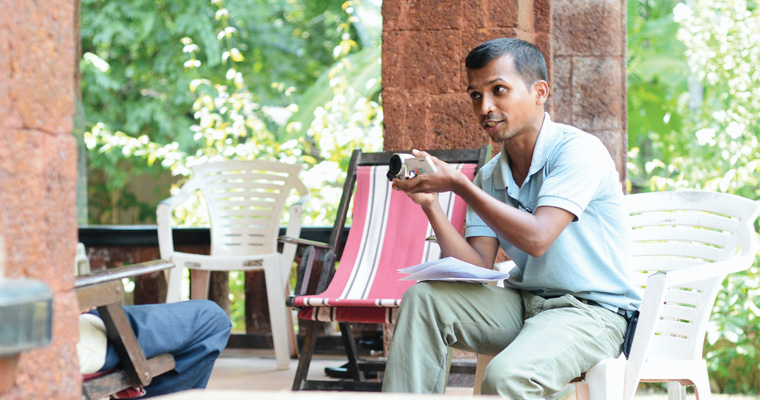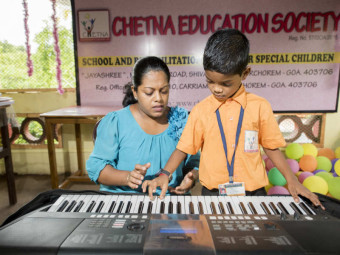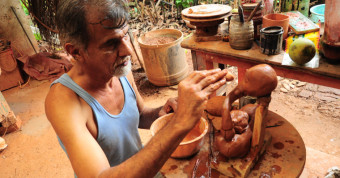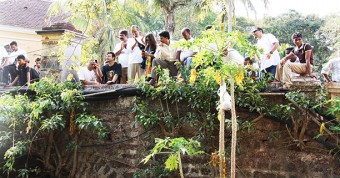Age has walked all over him. Forehead as wrinkled as a dry, shrivelled shitake mushroom. But sitting hunched over a chair, the village elder was humming a song when I was introduced to him at dusk. A song he has been singing ever since he has known he could sing. Mono Gaonkar could easily have been the last person from his tribe who knows what the rambling song is about.
Fortunately, he is not.
At 26, Devidas Gaonkar looks 19 and is an infectious bundle of energy that simply cannot be tamed. If he’s done answering you, he starts questioning. If he is done with questioning, he will tell you about the animals which inhabit the forests where he lives and then move on to describing the vegetation. Once a school dropout, he is today a custodian of ancient stories of the indigenous Velip tribe who live in southeastern Goa, especially the Quepem sub district.
Devidas highlights the need of preserving Sarantari — folk music that captures his tribe’s genealogical and cultural history. Sarantari songs have been sung by the tribe for several centuries. These are songs about their professions, art, culture, religion, social traditions etc.
Devidas was born into a farmer’s family in Cotigao, a remote village in South Goa, and had to drop out of school in 2003 because there was no money for education. But with his mettle, he didn’t need much money to chase his dreams. Over the years, an urge to tell a story and a passion to hear them led him to the doorstep of a video volunteer programme, where those interested in story telling were armed with a camera and asked to shoot stories. Stories that video-documented the struggles of his own community against the rampages of mining, focusing on the environment and fading traditions, all of which found no place in mainstream media.
He decided to record the ancient oral stories of the Velip tribe.
Stories like the one that traces the area’s largest temple, dedicated to Hindu Lord Mallikarjuna. As Devidas tells it, four Velip tribesmen once went to the forest to clear it for agriculture. One of the men accidentally hit his chopper on a stone, which suddenly started oozing blood and milk. Stunned, the Velip community began worshipping the stone as a manifestation of the Lord Mallikarjuna, an incarnation of the Lord Shiva. Dating back to the 16th century, the temple is the largest in the district of Canacona and one of the oldest shrines in Goa. To this day, the Velips remain in charge of it.
Not everyone was excited by Devidas’ decision to chronicle his people’s heritage.
“My own parents did not approve (of) my passion to document the unheard stories of our community. They said very discouraging words like ‘you are good for nothing’ whenever they found me sitting idle reading a book,” says Devidas, who has since earned his way through school and college, paying his fees by selling his thermacol art creations and paintings, plus writing stories for a local Marathi daily from Cotigao.
Villagers, too, thought that Devidas had lost it.
“‘Devidas toklen sutla’ (Devidas has lost his head) they would say,” he says.
“One thing that changed the mindset of the people and my family about my job was when the members of Video Volunteers’ Unheard India series visited my village and screened the documentaries done by me to my villagers … The behaviour of people towards me changed for good,” he said.
The Velip community’s oral stories, he says, have been passed on orally from generation to generation for centuries. But that has now largely stopped, as younger generations grow estranged from tradition.
Devidas explained that oral histories were actually stories passed on in whispers from old to young and reflected in social practices and traditional values.
“Our stories carry our wisdom. It is our stories that tell us that we are the descendants of the tribal king Balli. Without those stories our tribe is rootless,” said Mono Gaonkar, the Velip elder who is not related to Devidas despite their common surname.
“There are stories about the Balli king and his tales of valor. There are stories about jungle lore and the importance of environment. Almost all the stories are narrated in a local adaptation of the Konkani language,” says Devidas, who has captured several of these stories on his camcorder.
One such story tells of how King Balli slays a tiger in order to protect the lives of his tribesman. The story ends, however, with the king saluting the dead tiger for his valour. Traditionally, the stories are told both in song and narration, generally by more than one person. One person anchors the story-telling while the other pitches in with the occasional answer and fills in deliberate blanks in the story’s narrative.
“Worded in conversational script, the oral stories have a direct connect with the listener, engaging him or her in the narration,” Devidas explained.
The time to catch the stories is now, he says, because most of the stories are with the last members of an aging generation.
“The younger generation is embarrassed about this tradition. They feel their elders should get rid of this baggage and move on with the times. Narration of these stories to the Velip youngsters has virtually stopped,” Devidas said.
Here’s hoping that his video’s might just fill the void.




